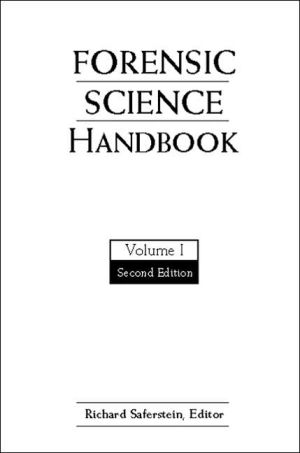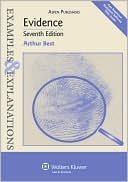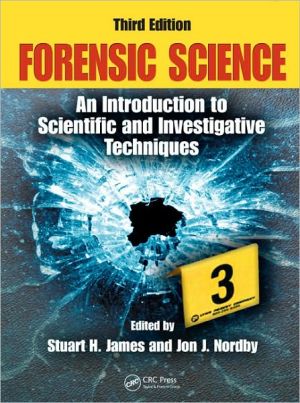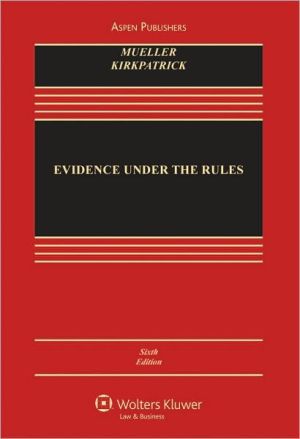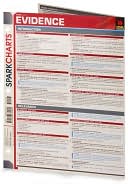Forensic Science Handbook, Volume 1
The second in a three-volume series, this popular and widely circulated professional handbook describes the theories and practices of today's criminalistics, and covers a wide range of subject areas relevant to the services rendered by crime laboratories and related facilities. Presents authoritative reviews from recognized forensic criminologists and forensic scientists well-versed in their chosen areas of expertise. Considers a specific examination technique for a wide-range of evidence...
Search in google:
Concentrating on the application of scientific principals in the crime lab, this volume addresses the legal aspects of forensic science, the applications of current technologies, and the examination of specific substances. Individual chapters cover high-performance liquid chromatography and capillary electrophoresis, mass spectrometry, microscopy, visible microscopial spectrophotometry, and the examination of glass, hair, paint, soil, blood, and documents. The contributors are forensic scientists, research chemists, toxicologists, microscopists, and scholars of criminalistics associated with universities, law enforcement agencies, and consulting firms. Annotation c. Book News, Inc., Portland, OR (booknews.com)
Forensic science is no different from any other scientific discipline; its growth and vitality are inextricably linked to the continuous accumulation of knowledge through discovery and experience. Science builds on past accomplishments; its rate of progress is measured by the caliber of published data and results. The first edition of Forensic Science Handbook was published in 1982. This book eventually grew into the current three-volume series. The three Handbooks have proven to be widely circulated professional reference books, as well as standard textbooks for graduate courses in forensic science. For the foreseeable future, the Handbooks will remain a three-volume collection. For the most part, the subjects to be found in this second edition of Volume I remain the same as in the first edition, but with an updated content. However, there are some notable additions to this revision. The impact of DNA technology has fundamentally changed the way forensic analysts characterize biological stains. The chapter "Modern Forensic Biology" details the field collection of DNA evidence and proceeds with a methodical updated treatment of the forensic laboratory's strategy for analyzing biological stains. Also, entirely new chapters have been added to the Handbook on the subjects of capillary electrophoresis and visible spectrophotometry.\ Forensic Science Handbook—Volume I places in one reference source authoritative, updated reviews embracing important areas of the criminalistic enterprise. The topics selected for inclusion in the Handbook are designed to provide the reader with material necessary to comprehend, evaluate, and appreciate the application and interpretation of scientific tests to an array of physical evidence. Chapters are devoted to discussions of examination techniques for a wide range of evidence found in the modern crime laboratory—DNA, hair, paint, soil, glass, petroleum products, explosives, alcohol in blood and breath, and questioned documents. The expanding applications of mass spectrometry, capillary electrophoresis, high-performance liquid chromatography, and the visible microspectrophotometer warrant the inclusion of chapters describing their theory, operation, and forensic use. However, the emergence of modern analytical instruments has not diminished the importance of the light microscope in criminalistics. The microscope's unique role in the crime laboratory has prompted coverage of its operational theory and applications to forensic science problems.\ A chapter describing the role and conduct of the expert witness and rules of evidence, as well as the legal requirements governing the admissibility of scientifically evaluated evidence, serves to emphasize the ties that bind forensic science to criminal law.\ The contributors to this volume of the Handbook are all recognized forensic experts well versed in the practices of their chosen areas of expertise. The expectation is that these authors will be successful in communicating to the reader knowledge and lessons derived from their many years of practical experience in laboratories and courtrooms. The editor deeply appreciates the enthusiasm and skills each contributor brought to this project. Their efforts are a mark of their professionalism and dedication to continued achievement and excellence in forensic science.\ I want to credit the efforts of Gonul Turhan, who aided me in reviewing the manuscript and tying up lots of loose ends while preparing the manuscript for production. I wish to express my appreciation to my production editor, Linda Pawelchak, for transforming the manuscript into a finished book. I also want to acknowledge my acquisition editor, Kim Davies, for supporting the Handbook volumes.\ The views and opinions expressed in the book are those of the contributors and do not necessarily represent those of any governmental agency.\ Richard Saferstein, Ph.D.\ Mt. Laurel, New Jersey
PrefaceChapter 1Legal Aspects of Forensic Science1Role and Attributes of Experts4Trial10Discovery and Disclosure11The Law of Evidence18Conclusion24Disclaimer24Appendix AQualifying Question Format for the Expert Witness25Appendix BExpert Witness Affidavit27Appendix CSubpoena Duces Tecum29Appendix DBasic (Initial) DNA Laboratory Report Subpoena32Chapter 2Forensic Applications of High-Performance Liquid Chromatography and Capillary Electrophoresis41High-Performance Liquid Chromatography42Capillary Electrophoresis69Appendix AHPLC Troubleshooting103Appendix BCE Troubleshooting107Appendix CReferences for HPLC and CE111Chapter 3Forensic Applications of Mass Spectrometry117Sample Ionization118Mass Analyzer133Sample Inlets138Data Acquisition and Processing141Applications145Chapter 4Forensic Glass Comparisons161The Nature of Glass162Glass Fractures173Glass Particle Examinations180Chapter 5Foundations of Forensic Microscopy215The Scope of Microscopy in Forensic Science216Elementary Theory of the Microscope: Light and Lenses217Varieties of Microscopes226Major Variants of the Compound Microscope230Microscope Components and Performance Criteria234Image Quality in the Compound Microscope256Specialized Contrast Enhancement and Illumination Techniques262A Brief Introduction to Polarized Light Microscopy269The Microscope as a Quantitative Measuring Tool293Microchemical Methods311Photomicrography313Chapter 6Visible Microscopical Spectrophotometry in the Forensic Sciences321Background of Colorimetry: Industrial Applications and Forensic Implications323Basic Instrumental Design Considerations330Calibration344Forensic Considerations354Questioned Item Considerations358Known Sample Considerations361Applications363Data Evaluation379Testimony380Conclusion381Appendix ABasic Definitions383Chapter 7The Forensic Identification and Association of Human Hair389History390The Pilary Apparatus391Hair Structure392Growth and Replacement of Hair401Identification of Human Hair406Association of Human Hair408DNA413Collection and Preservation of Evidential Hairs415Comparative Microscopy417Conclusions and Report Writing418Presentation of Evidence in Court419Chapter 8Forensic Pain Examination429Paint Chemistry431Forensic Examination of Architectural Paints458Forensic Examination of Automotive Paints469Forensic Examination of Artists' Paints471Evidential Value of Paint472Chapter 9Arson and Explosive Investigation479The Fire Scene Investigation: Collecting Fire Scene Evidence480Laboratory Examination of Fire Debris484Examination of Explosives and Explosives Residues498Analysis and Characterization of Explosive Materials and Residues510Conclusion518Chapter 10Modern Forensic Biology525Examining Evidence and Removing Biological Stains527Locating and Identifying Biological Stains of Forensic Significance531Identifying the Biological Origin of Stains: Species Identification546Individualization553Appendix AForensic STR Loci595Chapter 11Forensic Examination of Soil615Overview of Examination and Analysis of Soils618Micromeritics621Density Separation by Heavy Liquids622Light Microscopy622Special Methods in Light Microscopy625Electron Microscopy626Nonmicroscopy Methods of Analysis626Chemical Methods of Analysis627Procedures629Analysis and Data Reduction631The Future631Chapter 12The Determination of Alcohol in Blood and Breath635The Pharmacology and Toxicology of Alcohol638Analysis of Blood and Other Biological Specimens651The Testing of Breath663Alcohol and the Law686Chapter 13Questioned Document Examination697The Examiner of Questioned Documents699Required Laboratory Equipment701Preliminary Examination of Questioned Documents705Traditional Document Examination710Ink Examination727Paper Comparison and Dating738Pencil Lead Examinations742Index745
